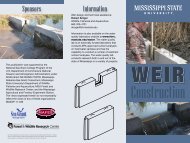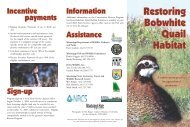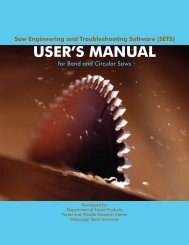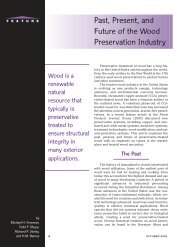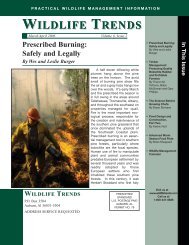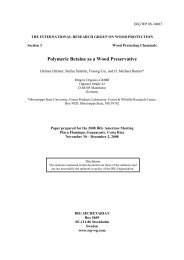“Treating” Treated Wood—Decks - Mississippi State University
“Treating” Treated Wood—Decks - Mississippi State University
“Treating” Treated Wood—Decks - Mississippi State University
You also want an ePaper? Increase the reach of your titles
YUMPU automatically turns print PDFs into web optimized ePapers that Google loves.
<strong>“Treating”</strong> <strong>Treated</strong> <strong>Wood—Decks</strong><br />
Terry L. Amburgey and Kevin W. Ragon<br />
SCH Report 8 2008<br />
Abstract<br />
The majority of the residential and non-residential decks in the US are fabricated using wood that<br />
has been pressure-treated with a water-borne preservative system. These preservatives will provide<br />
literally decades of protection from decay fungi and insects such as termites. However, it must be<br />
remembered that only the sapwood in “treated” materials is treated with preservative. Since any<br />
untreated heartwood that is present will be exposed as “treated” materials are cut to size, all cut<br />
surfaces should be treated by brush, spray or dip application on site with one of the preservative<br />
formulations that can be found at building supply stores. “<strong>Treated</strong>” cut ends of structural support<br />
members should be oriented away from the soil and protected from direct rain wetting by covering<br />
them with deck boards or capping them.<br />
Although they are protected from biological deterioration, the walking surfaces of approximately<br />
1/3 of all decks are replaced for aesthetic reasons after a few years of service. While the preservatives<br />
used to treat deck boards protect them from biological deterioration, they provide little protection<br />
from water absorption. Changes in moisture content of decking may result in checking, splitting, warping,<br />
cupping, or corrosion of fasteners. The “washboard” feel of some decks is caused by applying the boards<br />
“bark side down”. That is, applying the boards with the growth rings of the wood “cupping” toward the<br />
walking surface. We recommend that decking boards be installed “bark side up” to avoid splinters formed<br />
during “cupping”. All of these aesthetic defects can be minimized or eliminated by “treating” the exposed<br />
surfaces of treated decking with periodic topical applications (e.g. brush or spray) of a preservative<br />
formulation containing a water repellent, also available at building supply stores. We recommend that<br />
these topical “treatments” be applied as soon as the deck is finished, after the first year, and thereafter at<br />
3 or 5 year intervals.<br />
This publication is intended demonstrate to both those considering constructing new treated<br />
wooden decks, and those contemplating how to maintain them, the proper uses of treated wood to<br />
assure maximum service life through proper construction and maintenance techniques. Published<br />
averages from a survey of 205 deck builders and 213 home builders across the United <strong>State</strong>s suggest that<br />
one third of the decks currently being constructed are replacements for failing (primarily aesthetically<br />
displeasing) decks (5). As discussed at the 2007 American Wood Protection Association (AWPA) annual<br />
meeting, some replacement decks are failing due to inadequate structural supports, but not mentioned<br />
was that more often decks are replaced because of aesthetic deterioration and/or corrosion of fasteners<br />
caused primarily by relatively large changes in wood moisture content that cause wood to swell, warp,<br />
cup, twist, check, and split. The objective of this paper is to focus on moisture, its role in the slow<br />
deterioration of treated decking, and methods of preventing or minimizing moisture-related aesthetic<br />
deterioration of decks. Decks fabricated with untreated, naturally-durable wood, as may occur primarily<br />
in the western U.S., or composite/synthetic/extruded decking materials will be discussed only briefly.<br />
It should be remembered that, even when using alternative materials to treated wood for the walking<br />
surface, the framing still should be treated wood.<br />
Dimensional stability of wood is affected by moisture, and cycles of wetting (e.g., rain) followed<br />
by drying (e.g., combinations of wind, sun, and changes in temperature….collectively referred to as<br />
weathering) that eventually will lead to the aesthetic defects listed above. Weathering affects wood<br />
materials differently depending on species and size (12). These tend to be greater, and develop faster, in<br />
wider decking boards, so nominal six-inch wide decking usually is specified. While dimensional stability<br />
is, in general, not a problem with the composite/synthetic/extruded decking materials, many of these<br />
materials require that the framing members placed under them be closer together than with wood<br />
decking to minimize sagging and a “bouncy” feel. In addition, these materials tend to absorb heat from<br />
sunlight and may become very hot during the summer months.<br />
RESEARCH
H<br />
southern climatic<br />
mississippi state university<br />
SCH Report 8 2008<br />
Most decking boards are installed without<br />
regard to the grain orientation, and this often results<br />
in weathering-related defects such as splinters from<br />
cupping or raised grain. In new decks, we suggest<br />
orienting the decking boards “bark side up” (Figure<br />
1). That is, the growth rings form arcs from the<br />
bottoms to the tops of the boards when viewed<br />
from the ends. It is common to see cupping and<br />
checking in boards installed “bark side down” that<br />
allow water to pool on the surfaces and, eventually,<br />
cause splinters to form and the surface to assume<br />
a “washboard” feel. In boards installed “bark side<br />
down”, the growth rings cup towards the upper<br />
surface when viewed from the ends (Figure 2).<br />
The types of fasteners used in deck<br />
construction are very important for maintaining<br />
the long-term durability of decks because wood of<br />
most species used in deck construction is acidic,<br />
and treated wood may contain chemicals that are<br />
corrosive to some metals. Since the preservative<br />
formulations used to treat decking are waterborne,<br />
wood treated with nearly all of them has<br />
little water repellency and can absorb water from<br />
rains, especially at the ends and at holes created<br />
by fasteners. Since moisture accelerates corrosion,<br />
water accumulating adjacent to fasteners assures<br />
that those fabricated from metals incompatible with<br />
the preservative system used will occur (Figure 3).<br />
The International Building Code R319.3 (IBC,<br />
Chapter 3 BUILDING PLANNING, SECTION R319,<br />
PROTECTION AGAINST DECAY, R3 19.1 Location<br />
Required), has set a minimal standard for treated<br />
metal fasteners and reads as below (11):<br />
*R319.3 Fasteners.<br />
Fasteners for pressure preservative and fireretardant-treated<br />
wood shall be of hot-dipped,<br />
zinc-coated, galvanized steel, stainless steel,<br />
silicon bronze or copper. The coating weights for zinc-coated fasteners shall be in accordance with<br />
ASTM A-153.<br />
Exceptions:<br />
1. One-half-inch diameter or larger steel bolts.<br />
2. Fasteners other than nails and timber rivets shall be permitted to be of mechanically deposited<br />
zinc-coated steel with coating weights in accordance with ASTM B-695 (1), Class 55, minimum.<br />
Page 2<br />
Figure 1. A cross section of an older decking board showing the<br />
grain orientation bark side up, Bark side up orientation will help<br />
reduce weathering-related defects.<br />
Figure 2. (A.) is a cross section of a painted decking board that<br />
has been installed with the grain orientation bark side down. (B<br />
shows moderate raised grain (circled) and loosened grain (arrow).<br />
In unpainted wood these problems can lead to checking, splinters<br />
in bare feet, or tripping on the walking surface.
H<br />
southern climatic<br />
mississippi state university<br />
SCH Report 8 2008<br />
Generally, coated or dipped fasteners and connectors<br />
should conform to ASTM A153 which specifies a minimum<br />
coverage of 0.85 oz/ft2 of zinc and for areas in high corrosion<br />
zones a thicker coating (> 1.0 oz/ft2) is available from some<br />
manufactures (12). Most decking materials are treated with<br />
a formulation containing a form of copper such as CCA,<br />
ACQ, or ACZA and galvanized connectors and fasteners are<br />
recommended if not using stainless steel. The Southern Pine<br />
Council at southernpine.com states that when fasteners and<br />
connectors are used together they should be of the same<br />
composition to avoid galvanic corrosion. Typically, fasteners<br />
are not specified for either untreated, naturally-durable wood<br />
species or wood treated with specific preservative formulations.<br />
The US Forest Service recommends that hot-dipped<br />
galvanized steel fasteners be used with at least 0.85 oz/ft2 of<br />
zinc treatment (the same is recommended for connectors)<br />
Figure 3. (A.) shows a top view of 3 ½ inch<br />
(12). Most manufacturers of wood preservative formulations<br />
treated lag screws and a nail inside the decking,<br />
recommend the types of fasteners to use with wood treated<br />
(B.) is the bottom view of the same board<br />
withdrawn from its support on a 28 year old<br />
with their system (e.g., coated or stainless-steel nails or<br />
deck. In (B.) the corrosion of the lag screws (no screws). For information on treatment type and fastener<br />
threads) and nail have allowed the decking to choice for treated southern pine decking, go to southernpine.<br />
move freely on its supports which was common com, and click on Pressure <strong>Treated</strong> followed by Fasteners and<br />
to the majority of the boards on the deck. Notice Connectors. We suggest stainless steel lag screws or spiral<br />
the splitting near the end grain where moisture is shanked stainless steel nails for decking used in the southeast.<br />
absorbed by wood and where fasters are used for In the eastern portion of the US (Figure 4), especially the<br />
connection to the deck framing.<br />
southeast, rainfall can be acidic in nature, ranging from pH 4.3-<br />
4.7 (4). This, along with the specific wood treatment chemistry,<br />
is another reason why it is important to choose fasteners that<br />
are fabricated from materials that will resist corrosion.<br />
Generally speaking, deck maintenance is a “reactionary” practice, meaning that maintenance is only<br />
done after damage is noticed. Wooden decks have a life expectancy of 20 years according to Citi Bank<br />
and the National Home Builders Association (NHBA). If decks were built and maintained properly,<br />
their life expectancy should be double or triple this figure. It was estimated that 4.4 billion board feet<br />
of treated lumber are used annually to build replacement decks and, overall, pressure treated wood<br />
dominated materials in the construction of decks (5, 10).<br />
So, how can we “treat” treated wood decks, both during construction and maintenance activities?<br />
1. <strong>Treated</strong> wood columns (posts) used as either structural supports for deck surfaces or railings,<br />
if cut to expose new wood, should be installed with the original end oriented toward the soil<br />
and the freshly-cut end oriented upward. The upper end should be treated by brush or spray<br />
application with a water-repellent wood preservative (WRP) * (available from building supply<br />
stores) and covered with a cap or railing board to avoid direct exposure to the weather (Figure<br />
5) (9). This is because only the sapwood of most wood species is treatable, so if there is any<br />
heartwood in the column, and it is not re-treated with a WRP and protected from weathering,<br />
the untreated heartwood will decay and the piece need to be replaced (Figure 6). Also, avoid<br />
Page 3
H<br />
southern climatic<br />
mississippi state university<br />
SCH Report 8 2008<br />
Figure 4. Average pH of rain (1991), showing regions where water impacting decks would be most likely to<br />
contribute to fastener corrosion. http://www.eia.doe.gov/cneaf/pubs_html/rea/feature1.html (accessed in 2008)<br />
Figure 6. End grain of a CCA-treated southern pine support<br />
column from a deck exposed in AWPA Decay Hazard Zone 4 for<br />
26 years that had been cut to size and not protected by either a<br />
supplemental brush-on preservative treatment or a cap to cover<br />
the freshly-cut surface. The outer treated sapwood remains intact,<br />
but the inner non-treated heartwood has decayed, necessitating<br />
replacement of the column.<br />
Figure 5. A cap (circle) or railing board (arrow) should cover<br />
exposed end-grain of wood, after treatment with a waterrepellent<br />
preservative, to deter moisture from pooling on the<br />
end-grain of the wood.<br />
Page 4
H<br />
southern climatic<br />
mississippi state university<br />
SCH Report 8 2008<br />
placing the lower ends of columns directly into the soil and, as is frequently done, pouring<br />
cement around them. This practice traps water at the column bottoms and may lead to depletion<br />
of preservative and failure. Rather, either place them on raised concrete footings or pour<br />
concrete into holes where columns are to be placed, fill them to within a few inches (e.g., 12<br />
inches or less) of the surface with concrete, allow the concrete to solidify, place the columns on<br />
top of the concrete, and fill the area around the columns with washed gravel. Ideally, the bottoms<br />
of the columns should be placed into a bucket of WRP for a minute or two before being put<br />
into place or treated with a ground-line preservative such as is used with utility poles (Figure<br />
7). When ordering treated wood for use as columns, specify that materials are to be treated<br />
to ground contact retentions (tags on the material should indicate that it is treated for use in<br />
ground contact) (Use Categories UC4B or UC4C as specified in the AWPA Book of Standards)<br />
(2).<br />
2. Decking components should be joined with fasteners compatible with the preservative system<br />
that was used to treat them, as discussed above.<br />
3. Place decking boards with the “bark side up” (as discussed above) to avoid a “washboard” feel to<br />
the upper surface and to avoid splinters (Figures 1 and 2).<br />
4. Space the decking boards approximately 1/8-inch apart unless the decking was kiln-dried<br />
following preservative treatment (stamped KDAT), in which case wider (e.g., ¼ inch spacing)<br />
would be preferred before fastening into place. This will prevent buckling of boards as they shrink<br />
and swell with changes in moisture content.<br />
5. “Treat” the upper surfaces and ends of decking by brush or spray application of a WRP as soon<br />
as possible after construction is completed. This will minimize changes in moisture content and<br />
thereby decrease checking and splitting (9). These formulations will not prevent decking from<br />
turning gray, because surface “graying” is a result of interactions of the wood and sunlight (ultraviolet<br />
rays) at the wood surface. However, some WRP formulations also contain pigments to<br />
permit the homeowner to maintain whatever color is desired.<br />
6. After the first winter, re-treat the upper deck surfaces with WRP to increase their water<br />
repellency.<br />
7. Re-treat the upper deck surfaces in the spring either annually or at 3 to 5 year intervals with<br />
supplemental applications of WRP to maintain water repellency and minimize checking and<br />
splitting.<br />
* WRP formulations differ from water repellants because of an addition of a fungicide; a few examples<br />
are UltrawoodR, Wolman ExtraR, and WeatherShield (6).<br />
Page 5
H<br />
southern climatic<br />
mississippi state university<br />
SCH Report 8 2008<br />
Figure 7. <strong>Treated</strong> wood columns (posts) used as either structural supports for deck surfaces or railings, if cut to expose new<br />
wood, should be installed with the original end oriented toward the soil and the freshly-cut end oriented upward. (A.) the<br />
original treated end of the treated column was treated with a copper-boron paste (CuWrap 20) as a supplemental treatment<br />
before installation (B.) the treated end was covered with plastic to encourage diffusion and protect the treatment from the<br />
environment (a hole was cut into the bottom of the plastic to allow moisture to drain).<br />
Page 6
H<br />
southern climatic<br />
mississippi state university<br />
SCH Report 8 2008<br />
New Decks<br />
When building a new or replacement deck, it is important to plan ahead regarding design, materials<br />
to be used (wood columns treated to ground contact retentions and wood decking treated to above<br />
ground retentions), compatible fasteners, caps for column tops, and a WRP to be applied to decking<br />
and column tops as soon as possible after construction is completed. Since most treated wood decking<br />
materials are southern pine, much of this information can be obtained from the Southern Pine Council<br />
(southernpine.com) or the Southern Forest Products Association (http://www.woodfibre.com). These<br />
organizations produce volumes of literature on proper designs, grades of lumber, and use categories for<br />
building in AWPA Decay Hazard Zones.<br />
Once a design is chosen, list the decking materials to be purchased. Wood for use as decking,<br />
framing, and railings should be treated to above-ground retentions (noted on the tags, Figure8, and<br />
columns (posts) should be treated to ground-contact retentions (noted on tags). Fasteners should be<br />
compatible with the preservative system used (when in doubt, stainless steel screws or spiral-shanked<br />
nails should be specified). Unless the design chosen features techniques for protecting the column (post)<br />
tops from direct exposure to weather, metal or treated wood caps should be ordered. The supplemental<br />
treatment (WRP) chosen to be applied to decking and column tops should contain both a preservative<br />
and a water repellent.<br />
<strong>Treated</strong> materials usually arrive at the construction site with a moisture content ranging between<br />
35 and 75% unless they were kiln-dried following treatment (stamped KDAT) and kept dry (7). It is<br />
important to know the relative moisture content of the wood because of dimensional stability issues.<br />
KDAT materials will swell (increase in width) before reaching their equilibrium moisture content<br />
whereas treated wood not kiln-dried following treatment<br />
will shrink in width before reaching its equilibrium moisture<br />
content. In general, KDAT decking should be spaced farther<br />
apart (e.g., ¼ inch) than decking that has not been dried<br />
following treatment (e.g., 1/8 inch). Application of a WRP to<br />
the deck surface as soon as possible after construction and A<br />
thereafter at periodic intervals (see previous discussion) will<br />
decrease the shrinking and swelling of decking. Also as discussed<br />
earlier, it is important to pay attention to the grain orientation<br />
(bark side up) when fastening decking to the framing<br />
Supports<br />
Larger wood materials may contain more heartwood not<br />
penetrated during treatment. Supports like 4”x4”, 6”x6”, and<br />
so on are cut to size during installation. It is important to make<br />
sure that the uncut end is placed into the soil, supplement<br />
treatments are also available for posts that are going to be<br />
installed in harsh environments.<br />
In Figure 6, a post is being installed with the uncut end<br />
down, a copper borate paste, (Cu Wrap) has been toweled onto<br />
the post and covered to aid in the protection of the worker, soil,<br />
and penetration into the wood. The addition of pastes has been<br />
shown to significantly increase the life of wood (3).<br />
The tops of installed posts are exposed and will require<br />
B<br />
Page 7<br />
Figure 8. A.) Replacement materials for the deck in<br />
Fig. 13. The tags on the ends of the new decking (B)<br />
indicate that the lumber was treated with alkaline<br />
copper quaternary (ACQ) compounds, Type D by<br />
Georgia Pacific to a retention of 0.25 pounds per<br />
cubic foot and is to be used in AWPA use categories<br />
U1, UC3B (exterior construction, above ground) as<br />
defined in the AWPA Book of Standards. Each board<br />
was stamped on one face showing that the wood<br />
was inspected by an SPIB inspector who determined<br />
its grade to be No.2.
H<br />
southern climatic<br />
mississippi state university<br />
SCH Report 8 2008<br />
treatment. There is a wide range of oil-based topical treatments, borate applications, physical shaping,<br />
water repellants, and caps that can aid in protecting them. Water repellants can be applied by spray to<br />
support posts as seen in Figure 9. A cap, (Figure 4), can be used like the angled cut to shed water. Figure<br />
6 shows the top of a deck post that had no WRP applied and another post from the same deck also was<br />
not treated with WRP, but was shaped to shed water (Figure 10). A viscous borate formulation (Jecta)<br />
maybe applied to allow diffusion treating the untreated area before a protective cap is placed on the post<br />
(Figure 11).<br />
A 28 Year Deck – Example<br />
A 28 year old CCA-treated southern pine deck that was exposed to weather conditions at a<br />
site in American Wood Protection Association (AWPA) Decay Hazard Zone 4 (Figure 12) will serve<br />
to illustrate the points discussed above. Wood exposed in AWPA Zone 1 has a relatively low risk of<br />
deterioration and that exposed in Zone 5 has a severe risk. Wood exposed in Hazard Zones 2, 3, and 4<br />
have increasingly higher risks of deterioration. This deck was exposed to heat, cold, ice, water, wind, and<br />
UV exposure with no supplemental treatments with a WRP. The deck surface and railings were replaced<br />
after 28 years for $21,000.00 because of unsightly checks, splitting, and corrosion of fasteners. The<br />
treated wood had only limited decay in a few boards and was not in danger of failing. However, corrosion<br />
of fasteners had made the decking loose and it had begun to warp.<br />
The walking surface of the deck (Figure 13) at first glance shows extreme graying from UV exposure,<br />
warping, checking, and splitting giving the impression that the boards were decaying. The wood had<br />
been exposed to an average annual rainfall of 52 inches (1456 inches total) and an average temperature<br />
of 640F (180C), (high 770F (250C ) and low 520F (110C)) (8, 14, 15). These exposures, with no added<br />
WRP, resulted in checking and splitting, especially near the end grain, and accelerated the corrosion and<br />
subsequent failure of the mild steel fasteners (Figure 13). It was estimated that over 30% of the fasteners<br />
that held the sills, decking, and railing in place had corroded and were no longer functional. One decking<br />
board that had a section of heartwood showed signs of decay during its removal, a consequence of no<br />
supplemental maintenance treatments (Figure 14). The appearance of the walking surface, the feel of<br />
walking on loose boards and the decay seen in the untreated heartwood section on an initial inspection<br />
could indicate that the decking was unsound, but further inspection indicated just the opposite. Figure<br />
15 compares the walking surface to the bottom surface of the decking, indicating that the biological<br />
degradation of the wood was less than 1% of the total deck. Observing the bottom surface of the deck<br />
boards you could guess that the 28 year old wood was 3-5 years old until you looked at the walking<br />
surface. Figure 16 shows this comparison with the bottom surface. Although one split penetrates to<br />
the bottom side, the lower surface is free of checks and graying; the wood is sound. It is reasonable to<br />
believe that with periodic supplemental WRP treatments the deck would not have been replaced.<br />
A Research/Demonstration (R/D) house being constructed near campus by the <strong>Mississippi</strong> <strong>State</strong><br />
<strong>University</strong> Southern Climatic Housing Research Team* (SCHR) should be completed by summer, 2008.<br />
One of the primary objectives of the design features, construction techniques and experiments in the<br />
house is to determine/demonstrate methods of increasing the durability of residences in the southern<br />
climatic region to wood-inhabiting fungi and insects such as subterranean termites as well as to high wind<br />
events. One of the principal features of the R/D house is a deck and associated walkway that separate<br />
two components of the structure and provide access to them. The deck/walkway will be 320 feet long<br />
and will provide (40) 8-feet long test sections where alternative decking materials (both wood and nonwood),<br />
fasteners, preservatives (pressure and topically-applied), and periodic maintenance treatments can<br />
be assessed in replicated sections. In addition, the R/D house has two roofed porches and an open deck<br />
Page 8
H<br />
southern climatic<br />
mississippi state university<br />
SCH Report 8 2008<br />
Figure 9. Water repellants can be applied by spray or brush<br />
to the top of support posts to protect them from moisture<br />
and decay.<br />
Figure 11. (A.) A viscous borate solution being applied to<br />
the top of a deck railing post before it was covered by a<br />
galvanized top.<br />
Figure 10. In contrast to the post shown in Figure 6, this<br />
post on the same deck was cut at the top to shed water<br />
and experienced much less decay.<br />
Figure 12. American Wood Protection Association (AWPA)<br />
Decay Hazard Zones. Wood exposed in AWPA Zone 1<br />
has a relatively low risk of deterioration and that exposed<br />
in Zone 5 has a severe risk. Wood exposed in Hazard<br />
Zones 2, 3, and 4 have increasingly higher risks of<br />
deterioration.<br />
Page 9
H<br />
southern climatic<br />
mississippi state university<br />
SCH Report 8 2008<br />
Figure 13. A 28 year old CCA-treated southern yellow pine<br />
deck exposed in AWPA Decay Hazard Zone 4 that had no<br />
supplemental maintenance treatments.<br />
Figure 15. The top (A) and the bottom (B) horizontal<br />
surfaces of the deck in Fig.13. The upper surface (A.) is<br />
characterized by discoloration, splitting, checking, cupping,<br />
warping and loose boards resulting from failure of fasteners<br />
whereas the bottom surface (B.) looks essentially new.<br />
Figure 14. A decking board that had a section of<br />
heartwood that showed signs of decay during its removal, a<br />
consequence of no supplemental maintenance treatments.<br />
Figure 16. The top (A) and bottom (B) surfaces of a deck<br />
board removed from the deck in Fig. 13. (B) shows that the<br />
fasteners (lag bolts and screws) were deteriorated but the<br />
wood looks good except for one split that originated from a<br />
check on the upper surface. The bottom side indicates that,<br />
if protected from weathering, treated wood will deteriorate<br />
very slowly.<br />
Page 10
H<br />
southern climatic<br />
mississippi state university<br />
SCH Report 8 2008<br />
where these variables can be tested.<br />
LITERATURE CITED<br />
1. ASTM. 2006. ASTM F2329-05 Standard Specification for Zinc Coating, Hot-Dip, Requirements<br />
for Application to Carbon and Alloy Steel Bolts, Screws, Washers, Nuts, and Special Threaded<br />
Fasteners. Volume 01.08. www.astm.org.<br />
2. American Wood Protection Association. 2007. Book of Standards. www.awpa.com.<br />
3. DeGroot, R.C. 1981. Groundline Treatments of Southern Pine Posts. U.S. Department of<br />
Agriculture, Forest Service, Forest Products Laboratory. FSR-409<br />
4. Department of Energy. 1991. Electric Utility Power Plants Subject to Emission-Control<br />
Requirements of Phase I of the Clean Air Act Amendments of 1990. http://www.eia.doe.gov/<br />
eneaf/pubs_html/rea/feature1.html.<br />
5. Eastin, I, Ganguly, I., Shook, S. and Brackley, A. 2005. Material Use in the US Deck Market: An<br />
Assesmetn of the Market Potential for Alaska Yellow Cedar. July. http://www.cintrafor.org/index.<br />
htm.<br />
6. Falk, B. and Williams, S. Details for a Lasting Deck. The Best of Fine Homebuilding:Porches, Decks,<br />
& Outbuildinngs. The Taunton Press. Pg 62-66.<br />
7. Falk, B., McDonald, K., and Winandy, J. Controlling Moisture in Deck Lumber: Many problems<br />
associated with deck deterioration can be traced to the original moisture content of the lumber<br />
The Best of Fine Homebuilding: Porches, Decks, & Outbuildinngs. The Taunton Press. Pg 60-61.<br />
8. Forest Products Laboratory. 1999. Wood handbook—Wood as an engineering material. Gen. Tech.<br />
Rep. FPL–GTR–113. Madison, WI: U.S. Department of Agriculture, Forest Service, Forest Products<br />
Laboratory. 463 p.<br />
9. Gorman, Thomas M.; Feist, William C. 1989. Chronicle of 65Years of wood finishing research at<br />
the Forest Products Laboratory. Gen. Tech. Rep. FPL-GTR-60. Madison, WI: U.S. Department of<br />
Agriculture, Forest Service, Forest Products Laboratory. 81 p.<br />
10. Howard, James L. 2003. U.S. timber production, trade, consumption, and price statistics 1965 to<br />
2002. Res. Pap. FPL-RP-615. Madison, WI: U.S. Department of Agriculture, Forest Service, Forest<br />
Products Laboratory. 90 p.<br />
11. International Code Council. 2006. International Residential Code. Chapter 3 Building Planning,<br />
Section R319, Protection Against Decay. http://www.iccsafe.org/.<br />
12. McDonald, K.A, Falk, R.H., Williams, S.R. and Winandy, J.E. 1996. Wood Decks: Materials,<br />
Construction, and Finishing. U.S. Department of Agriculture, Forest Service Forest Products<br />
Laboratory, Madison, Wisconsin. Forest Products Society.<br />
Page 11
H<br />
southern climatic<br />
mississippi state university<br />
SCH Report 8 2008<br />
13. National Association of Home Builders/Bank of America Home Equity. 2007. Study of Life<br />
Expectancy of Home Components. http://www.nahb.org/.<br />
14. National Oceanic and Atmospheric Administration. 2008. Report Complied (30 year) from Data<br />
Collected from NOAA Reports in <strong>Mississippi</strong>. http://www.noaa.gov.<br />
15. Weather Channel. 2008. Average Temperature and Rainfall for Starkville, MS. www.weather.com.<br />
The MSU Southern Climatic Housing Research Team is a collaborative effort involving Architecture, Civil Engineering, Electrical<br />
Engineering, Forest Products, Landscape Architecture, and Mechanical Engineering. The MSU Southern Climatic Housing<br />
Research Team is affiliated with the Coalition for Advanced Wood Structures (CAWS) as a partnership with the USDA<br />
Forest Service, Forest Products Laboratory in Madison, Wisconsin. CAWS is a partnership between universities, industry and<br />
government to advance research for wood structures related to residential, non-residential and transportation uses.<br />
H<br />
Page 12<br />
southern climatic<br />
mississippi state university<br />
<strong>Mississippi</strong> <strong>State</strong> <strong>University</strong> complies with all applicable law regarding affirmative action and equal opportunity in all its activities and programs and does not discriminate against anyone protected by law because of age, color, disability,<br />
national origin, race, religion, sex, handicap, or status as a veteran or disabled veteran.



